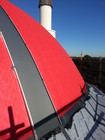- 267-263-2308
- info@uspunderlayment.com
SRP AirOutshield™ Roof
SRP-AirOutshield Roof Breathable Underlayment Installation Guide
The following is a general installation guide for SRP-AirOutshield Roof. Always follow industry best practices. If you encounter a condition not described here contact SRP Canada.
AUXILIARY MATERIALS
Detail Tape: SRP-Eternabond 4” Detail Tape, 30 mil, single sided. To seal SRP-AirOutshield Roof to itself and to other surfaces and substrates.
Seam Tape: SRP-Eternabond 1” D.S (double sided) Seam Tape distributed by SRP Canada Inc. 30 mil. To seal vertical and horizontal seams between layers of SRP-AirOutshield Roof.
Factory Formed Corners: SRP Pre-Fab Curb Corners, 18”x18”, distributed by SRP Canada Inc., used on roof top penetrations such as curbs.
Self adhered eave protection membrane: Regular temperatures: High Temperature:
Ventilation Mat: R-Vent by Advanced Building Products, 6mm thick non woven nylon with maximum 20% contact area.
Fasteners: Minimum No. 12-gage [0.109-inch-shank-diameter (2.77mm)] corrosion-resistant steel or stainless steel nails having a minimum 3/8-inch diameter (9.5 mm) head, or minimum No. 14 gage [0.083- inch-shank-diameter (2.11 mm)] corrosion-resistant steel or stainless steel screws or nails installed with a 1- inch-diameter (25.4 mm) caps, plate or washer.
SURFACE PREPARATION
Clean and prepare to provide a clean and dry substrate free of frost, loose nails, dirt, debris or other containments that would adversely affect the installation of the breathable underlayment.
Do not expose the membrane to chemicals including surfactants (soaps), solvents or other chemicals.
PENETRATIONS
Pipes and Conduit
1. Install manufactured penetration sleeves sized for the penetration and install as recommended by the manufacturer.
2. Unroll SRP-AirOutshield Roof membrane next to penetration and fold membrane back on itself. Mark and cut out penetration size out of membrane. Ensure cutout section is slightly smaller than diameter of penetration. Slide membrane over penetration.
3. Wrap SRP-Eternabond 4” detail tape around penetration. Ensure that 2” extends onto the membrane. If required, install a second 4” piece of SRP-Eternabond detail tape around the penetration. (See standard details)
Large, Curbed, Roof Penetrations
1. Follow roof manufacturers and curb manufacturer’s approved shop drawings for curb and roof system installation.
2. Unroll and install SRP-AirOutshield Roof membrane around curb. Install SRP Pre-Fab Curb Corners. Using strips of SRP-AirOutshield Roof, flash curbs connecting SRP Pre-Fab Curb creating a continuous flashing.
3. Using SRP-Eternabond 4” detail tape, seal all flashings strips and pre-Fab corners together. (See standard details)
EAVE PROTECTION
At eaves, install a self adhered eave protection membrane as required by local codes. BREATHABLE UNDERLAYMENT APPLICATION
SRP-AirOutshield Roof is installed as a secondary drainage plane under the primary water shedding roofing such as tile, slate, zinc, copper or metal roofing material.
1. Install orange side up, laid such that it forms a continuous membrane over the entire roof area, allowing any water to drain down to the gutters. Avoid blockages that would otherwise obstruct the water flow.
2. Do not use on roofs with slope less than 2:12 (16.7 %).
3. Fasten using roofing nails or screws. Staples are not recommended. Ensure compatibility between fasteners and the roofing material.
4. Take appropriate precautions during installation in high winds to avoid injury.
5. Along valleys, hips and ridges, install a layer of self adhered eave protection membrane. At ridge of roof, ensure horizontal overlap, minimum 12” o.c. both sides.
6. At eaves, install SRP-AirOutshield Roof overlapping the self adhered eave protection membrane by 12 inches minimum.
7. Unroll SRP-AirOutshield Roof horizontally across the roof perpendicular to roof slope. Install successive layers of SRP-AirOutshield Roof in a shingling manner up the roof slope maintaining minimum 6” horizontal and vertical overlaps.
8. Tape all seams when roof slope is 3:12 or less or as required by this specification using SRP- ETERNABOND 1” D.S. Double Sided Seam Tape.
9. OPTIONAL Tape all vertical and horizontal seams using SRP-ETERNABOND 1” D.S. Double Sided Seam Tape.
10. Extend AirOutshield Roof 4” over gable ends and fasten to fascia boards at 12” o.c.
11. Fasten AirOutshield Roof along top and bottom of roll at 12” o.c. and maximum 2’-0” o.c. in the field.
12. During installation, protect AirOutshield Roof from rainwater runoff from upper to lower roofs (overhangs/eaves/valleys).
13. Limit heavy foot traffic on AirOutshield Roof and repair any damaged material due to traffic abuse.
14. AirOutshield Roof is not to be covered by asphalt shingles.
Roof Installation
1. Ensure SRP-AirOutshield Roof is installed in compliance with this specification and all details are complete.
2. OPTIONAL Install R-Vent Ventilation Mat over the AirOutshield Roof to form a positive drainage and ventilation space.
3. Install primary roofing system as soon as possible and in accordance with the roof system manufacturers written instructions and the project specifications.
PROTECTING AND CLEANING
1. Protect installed SRP-AirOutshield Roof from damage due to ultraviolet light, harmful weather exposures, physical abuse, and other causes. Augment SRP-AirOutshield Roof with additional waterproofing materials (e.g., tarps) DURING THE CONSTRUCTION PHASE to ensure that interiors are protected until the primary roofing material is applied. Manufacturer suggests a maximum of four (4) months UV exposure.
2. Repair torn breathable underlayment as follows:
3. Insert a full height piece of underlayment extending 12 inches horizontally beyond the damage and extend up and under the underlayment above. Mechanically attach underlayment to substrate top and bottom. Tape all seams.
4. Remove mud and similar marks with a water scrub. Do not expose the membrane to chemicals including surfactants (soaps) or solvents. If chemicals have been spilled on underlayment, remove and replace as stated above.




